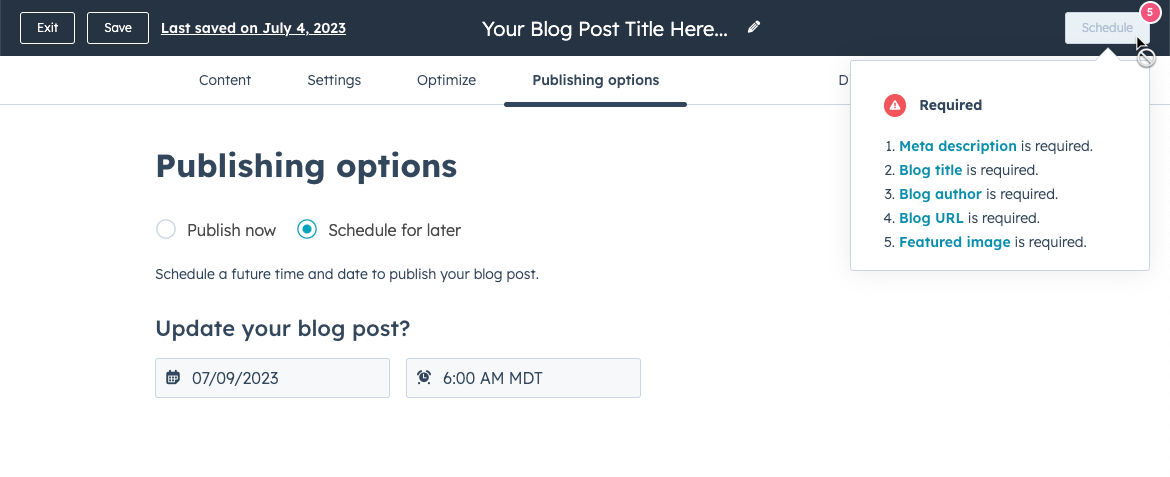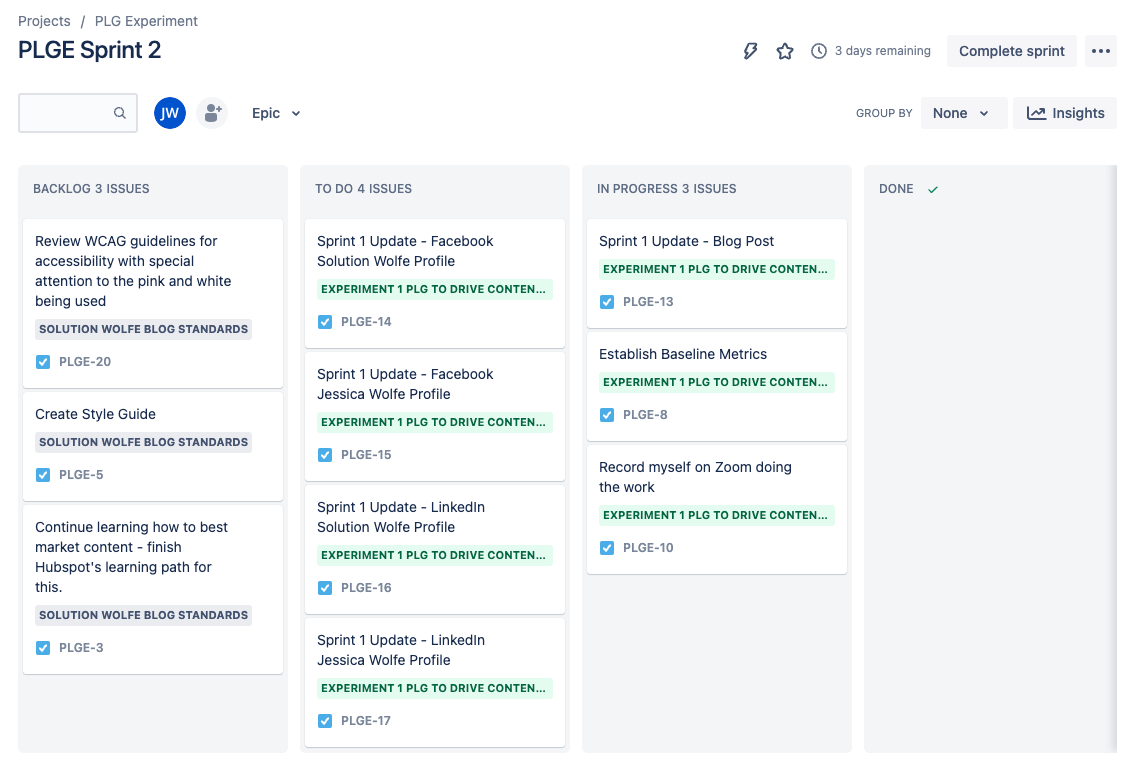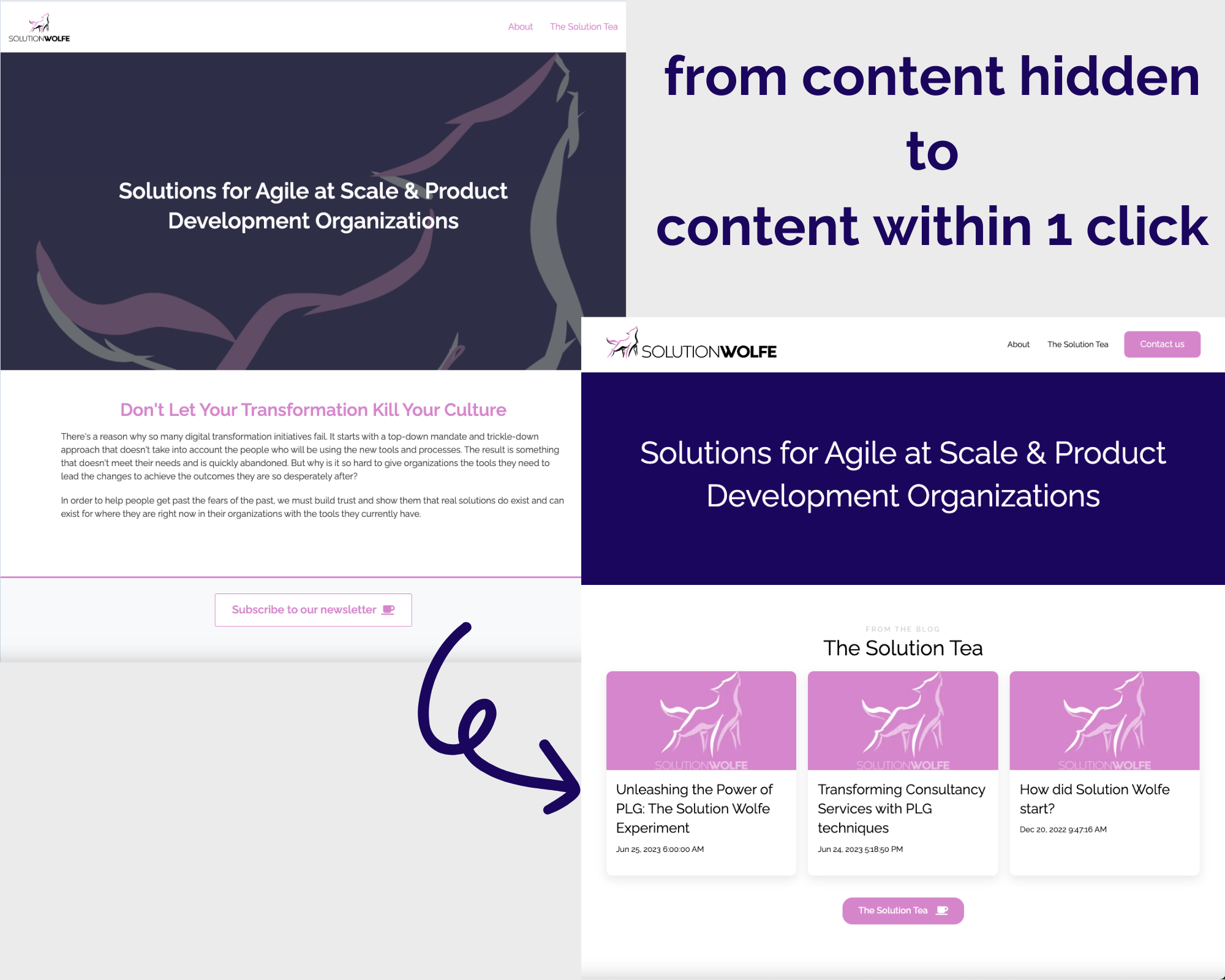Sprint 1 Retro: Leveraging Customer Centricity, PLG & the Scientific Method
TLDR
-
This first week of the experiment was tactical with the focus on building the foundations so the Solution Wolfe website has the ability to maintain better customer centricity. The website UI has been adjusted to drive a better flow to value. While still imperfect, it’s a first step.
-
Leveraging the following analytics tools to validate experiment OKRs
-
Hubspot (Marketing Hub Starter)
*If you decide to purchase Hubspot through this link, you'll be eligible for a 14-day trial, and we'll receive a small commission. - Confluence Cloud Premium
-
-
A story about a cytogenetics laboratory in it’s startup phase that lends itself to ways to think about being customer centric which is the foundation of product-led growth
-
The next focus will be leaning into the feedback received in order to further improve the content experience
-
Going forward, weekly updates every Sunday on the solution tea blog, Facebook and LinkedIn
Experiment Summary
I decided to do an experiment with Solution Wolfe using the internet, Google Analytics, Hubspot, LinkedIn, Atlassian Cloud Premium and Meta Business Suite to show how to leverage customer centricity techniques to drive growth around content.
Why am I sharing this journey in real time instead of just summarizing it later? Let me explain.
The truth is, when it comes to customer centricity and product-led growth, it doesn't always go as expected. It's not as predictable or straightforward as we would like it to be. That's why I want to take you along on the journey, to show you firsthand how the creative process unfolds.
Yes, there will be mistakes along the way. I'll be wrong in real time. But that's okay. I want to demonstrate that it's not something to be afraid of. Instead, we can learn from those mistakes and turn them into valuable "features".
What I Did in Sprint 1
During the first sprint, I focused on making changes to the blog post, UI, and website schemes. The main objective was to gather feedback from a broader audience, and I achieved this by sharing the updates on social media platforms. I learned that Facebook only allows users to share links on their personal profiles instead of a direct link to a post, which was quite limiting. Nonetheless, the engagement and feedback from LinkedIn were encouraging, and it gave me a clearer picture of what my audience wants.
June 24th
I created my very first scheduled blog post on Hubspot. The process for setting it up was surprisingly straightforward. I'll likely continue this practice in the future, as it will allow readers to anticipate when new content will be available.
Here’s what the process looks like to schedule a blog post on Hubspot
| Once you are in your blog, navigate to Publishing options and select Schedule for later |  |
| Once you resolve scheduling conflicts, you will be ready to schedule the post for publishing. Super simple! |  |
June 25th
The next morning, I checked if the post had been successfully posted and found out that it was. While I was there, I read the blog and decided to make some minor changes to the wording of the experiment objectives and key results. Below is a comparison between the original and updated versions. Please let me know your thoughts on whether the changes were an improvement.
| Scheduled Post | Adjusted Post |
 |
 |
Once the blog felt better, I shared it on Facebook with my personal account. I like to do this as an early test with a friendly audience who I mostly know in real life. I like to give time for the audience on Facebook to respond before I post to a larger more professional audience on LinkedIn.

Although further experimentation is needed, I believe that my personal Facebook audience could potentially serve as a control group in comparison to the Solution Wolfe audience on LinkedIn and my personal audience on LinkedIn. I am comparing the metrics of Solution Wolfe's Facebook page to its LinkedIn page. Since Solution Wolfe did not post the experiment on Facebook, it will be interesting to observe if it gains more traffic if I repost it on my personal Facebook profile as part of the journey people want to take.
June 28thIn my previous post, I discussed some specific strategic changes I planned to make to the Solution Wolfe homepage experience. However, I want to acknowledge that this is just one of the possible entry points to the website, as visitors may also arrive through our blog or other means. Since updating the homepage, I have written a blog post about the changes. You can read about them here: Objective 1 - Minimize Friction from the Experience
After posting the blog, I shared it to my personal Facebook audience...


June 29th
I received positive feedback on Facebook and decided to post about my experiment on LinkedIn using the Solution Wolfe profile. See post here

Then I reposted the Solution Wolfe post to my personal LinkedIn audience. I’ve been told this is the key to success on LinkedIn as the algorithm caters to people over businesses. I don’t have any hard data to prove this so don’t quote me. See post here

June 30th
I took a leap of faith and tackled updating the rest of the website schemes. This really wasn’t as bad as I anticipated. However, I still need to make some improvements to the blog's user experience. Specifically, I noticed repeating social share buttons and the layout feels too cramped.
I came across a bug that caused the ‘<-- All posts’ link to take users back to the old UI instead of displaying all posts. To address this, I added a redirect for that specific URL to direct users to the landing page for The Solution Tea blog.
What I learned
1) I dislike the fact that Facebook does not provide a direct link to a specific post.
It is difficult to create a quick social share outside of Facebook on other social platforms since Facebook does not allow direct links to posts even if they are available to the public. All sharing must be done within Facebook or through embedding, unlike LinkedIn which makes it easy (as shown in the picture below).

2) Folks are looking at PLG as if it's yet another heavy process like SAFe 🚫
I had some great discussions about the content this week, both publicly and privately. However, I was surprised to find out that some people see PLG as just another framework or a replacement for SAFe. I want to clarify that this is not the case, and explain how I approach using product-led growth techniques to create value. It all starts with customer centricity. It would be obvious to leverage my experience at Atlassian but I'd like to share an experience I had in my early 20's that set my foundation for how I think about optimizing for the experience today.
It all started when I was a cytogenetic technologist and we focused on implementing lean-six-sigma techniques to improve the flow of value when creating results for the doctors using the specimens they provided. At the time, we had a paper chart that followed each specimen around and the laboratory decided it was time to digitize as well. Now, I am applying the same optimization concepts I learned so early in my career to customer centricity. I've seen many agile transformations and talked to many customers who were using products that support agile ways of working and often they are missing a critical piece of the puzzle to drive positive outcomes for an organization.
Many companies fail to realize that they are responsible for the entire customer experience, from start to finish.
Companies need to understand that they are accountable for the complete customer experience, right from the beginning to the end. If they focus only on their own optimization, they might end up providing a substandard experience to their customers. This is a common issue with agile transformations, where organizations prioritize their own capabilities to boost efficiency without considering what's best for removing friction from customers so their path to value is also enjoyable. It's important to make sure that the customer journey is optimized from the customer's perspective, not just the organization's. Solving this problem is challenging because each customer's optimal experience is likely to vary based on their individual perspective.
Adding to the mentioned challenges, the lab is also under high regulation and must follow all Federal and State guidelines as well as standard operating procedures accordingly. From the focus of the lab, we think about the journey of the specimen as if it were the customer because essentially it is the customer. That patient result is what matters most because a lot of times, doctors are waiting for results while the patient could be being treated to prevent further damage and even the worst case scenario. This is why it was so important to understand the journey a specimen takes to create the most efficient path to a result in which a doctor needs to make an important decision about a patient's plan of care.
A lesson I learned while working in a laboratory that was transitioning from start-ups to becoming more efficient is that you want to understand the jobs that support the flow of value along the way. In the case of the cytogenetics laboratory, it often started with the hospital or clinic ordering a test through an electronic system. That was our early indicator of what kind of flow of specimens needed to be processed in the upcoming days.
Once the test is ordered, a specimen is drawn from a patient in an appropriate setting. Often this would include an ordering physician, attending physician, and sometimes one to many referring physicians (all different stakeholders). Sometimes they were the same person and other times they were doctors from different medical groups each with their own needs and expectations. In product development, we work with our stakeholders similarly as the laboratory would work with the physicians. While we want to have one standard of operating, often that is unachievable across so many other businesses who also what to have one standard of operating.
The folks who were responsible for optimizing the lab became obsessed with the journey of the specimen from the time the it was drawn through the collection and storage and transit journey through accessioning and processing to the correct splits so each specialty has the right amount of specimen in the right container in the right conditions to run the test, to capturing the test results and getting those results to the doctor as fast as possible. Every department was responsible for a set of tests that could be run on a specimen. The journey of these specimens across all the departments (and even specific jobs within the departments that needed to be done to complete the experiment that drove the results) was mapped out and the departments were then moved around to optimize the flow (minimal steps/movement). The key that they focused on was also making value visible with a specimen tracking tool that was integrated into the reporting tools that already existed. They made the compliance required and time heavy jobs visible in the tool. Centering around the jobs that were necessary to drive value along the most optimal journey (while making that journey as optimal as possible).
You can apply this concept to every interaction (such as clicks, calls, and ads) throughout your audience's journey beyond your website. Focus on making it easy for them to get value and avoid anything that creates more work for them. Engagement will naturally happen through PLG (product-led growth) if you focus on the value your customer can get at every step of the journey. Pay attention to your audience's feedback and optimize their experience to make it worthwhile to go on a journey with you.
3) If the goal is to create value, how do you define value?
Just like beauty, value is in the eye of the beholder. As I continue to experiment and learn more about my audience, my definition of value will adapt accordingly. The value I offer will be tailored to the specific audience that I attract.
What I'm Doing in Sprint 2
During Sprint 2, I will focus on implementing the feedback I received from the audience to improve the content experience further.

Cadence to Expect Updates
Starting from now, you should expect to receive weekly updates every Sunday regarding the progress that has been made each sprint. You can keep track of these updates by checking my blog, Facebook, and LinkedIn as we move forward on this journey together.
Why this update is late?
I was in 4th of July & Dead and Company mode all weekend as they were in town playing at Folsom Stadium. The Dead and Company show was absolutely the most amazing display of love and enjoyment for one’s craft. I have never been at a show where it really felt like there was no ego from the band, all love for the journey they are on together, it being the final tour. The audience was like something I have never seen. All, one community of people there for the experience of a jam band simply loving to jam.
During the concert I was sitting a row behind some really nice folks. One who I was talking to, also named Jess gave me this and said from one Jess at this historical moment to another, I want you to have this.

I now know I was talking to Capt. Jessica Barlow, an emergency room physician with the 378th EMDS. Check out this amazing display of teamwork, preparation and optimization of the jobs that need to be done that go into just one exercise in effort to maximize saving life in a mass casualty. 378th medical partnerships sustain life and mission

 By
By

